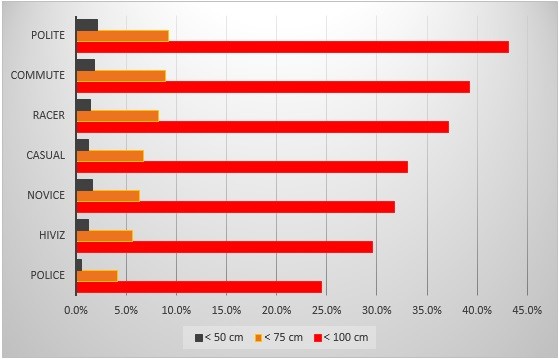
News Ltd reporter Susie O’Brien wrote an article yesterday for the Herald-Sun about the perennial differences between motorists and cyclists when it comes to sharing road space (Curbing the road wars between motorists and cyclists).
She avoids the hysterical tone all too common with News publications and tries to be reasonable and even-handed:
I welcome the fact that commuter cycling has increased by 35 per cent in the past five years. This is a good thing. But cyclists — and not just drivers — need to do more to make the roads safe for all of us.
She doesn’t avoid the usual tropes though: cyclists who don’t own a car don’t pay for roads; bicycles should be registered; giving cyclists one metre puts drivers at greater risk. There are also some errors of fact, and some doubtful propositions too. (1)
This is stuff I’ve discussed before so I won’t go into it again now. What I’m interested in now is what happened when Ms O’Brien took to Twitter to publicise her story:
Cyclists need to do more to be safe on the road. When did you last see a rider in a high-vis vest?
Someone on Twitter told her pretty quickly she “should stop making stuff up”; new research shows her claim about the usefulness of high-visibility clothing is “incorrect”. He referred her to an article in the Canberra Times under the heading, High-visibility clothing won’t help cyclists.
The newspaper cited a recent University of Bath study that found “high-visibility clothing does not deter drivers from dangerously overtaking cyclists on shared roadways”. One of the researchers is quoted as saying:
Many people have theories to say that cyclists can make themselves safer if they wear this or that. Our study suggests that, no matter what you wear, it will do nothing to prevent a small minority of people from getting dangerously close when they overtake you.
This is an important and for most probably a surprising finding. As is so often the case though, the reality is not as black and white as either Ms O’Brien or those who took her to task on Twitter believe.
You can read the paper here: Walker I, Garrard I, Jowitt F, The influence of a bicycle commuter’s appearance on drivers’ overtaking proximities. Or you can read the University’s press release: Cyclists cannot stop drivers overtaking dangerously, research suggests.
The researchers measured the distance that motorists allowed when they overtook a cyclist. They hypothesised that what a cyclist wore proxied for the cyclist’s level of experience, inducing motorists to leave more space for riders they judged to be less skilled.
Five outfits were tested, ranging from a stereotypical sport rider’s outfit, portraying high experience and skill, to a vest with ‘novice cyclist’ printed on the back, portraying low experience. A high-visibility bicycling jacket was also used, as were two commercially available safety vests, one featuring a prominent mention of the word ‘police’ and a warning that the rider was video-recording their journey, and one modelled after a police officer’s jacket but with a letter changed so it read ‘POLITE’.
An ultrasonic distance sensor was used to measure the distance between vehicles and one of the researchers on his daily bicycle commute. In total, 5,690 data points fulfilled the criteria for the study and were included in the analysis. (2)
The headline finding is that, except in the case of the ‘police’ vest, there was no significant relationship between what the cyclist wore and the average amount of space left by overtaking motorists. In the former case the mean overtaking distance was 1.22 metres but in the others it varied between 1.14 and 1.18 metres.
However there’s more to it. The researchers defined a “close” pass as less than one metre; that’s consistent with the “a metre matters” campaign. They found the proportion of overtakes closer than one metre was correlated significantly with the way the cyclist dressed.
As the exhibit shows, more motorists (43.1%) passed within a metre of cyclists dressed in ‘polite’ attire, than those dressed in ‘police’ attire (24.5%) or those wearing high visibility clothing (29.6%). This relationship also remained significant for overtakes of less than 0.75 metres.
They found 1 – 2% of motorists passed “extremely close” (within <0.5 metre) when overtaking. However the distance they left did not vary significantly as a function of how the cyclist was dressed.
This is the group the researcher was referring to when he told the Canberra Times “no matter what you wear, it will do nothing to prevent a small minority of people from getting dangerously close when they overtake you”.
So how a cyclist dresses won’t protect them against this very small group of motorists; they’re the ones who’re blind to high-visibility clothing. I suspect they’re a group that cyclists can do little about. It seems reasonable to assume they’d be over-represented in collisions with cyclists.
But there are a couple of other important points. First, motorists who pass within less than one metre when overtaking are also likely to be over-represented in crashes; they’re also likely to discourage cyclists by undermining feelings of subjective safety.
As the exhibit shows, high-visibility clothing confers a protective effect against them as well as against drivers who pass within less than 0.75 metres. And importantly, there’re many more motorists in these two groups than in the group who overtake within 0.5 metres.
Second, overtaking isn’t the only or the most important situation in which high-visibility clothing might provide a real safety benefit for cyclists. It’s also important for being seen, especially at dusk or night i.e. for avoiding the “sorry, I didn’t see you” excuse from motorists. As the researchers acknowledge:
(High-visibility) clothing is intended primarily to make riders less likely to be overlooked, rather than influence the behaviour of people who have already seen them.
What constitutes “high-visibility” is a complicated area: it doesn’t necessarily mean bright and reflective. The researchers suggest that ‘high-contrast’ rather than ‘high-reflectively’ is more important in daylight. They say it might be that dark clothing impairs conspicuity more than bright clothing enhances it.
I think the researchers are probably right to conclude that on average cyclists’ attire won’t do much to change the behavior of the 1 – 2% who overtake extremely closely. It’s likely they’re a potential danger to cyclists in other ways too.
I also expect some cyclists have an inflated idea of the degree of protection higher visibility offers. However I wouldn’t conclude from this study that “high-visibility clothing won’t help cyclists” when it comes to other risks like simply being seen, or the large proportion of drivers who overtake within the sub one metre range.
________________________
-
Motorists are responsible for 79% of crashes between cyclists and motorists according to an Adelaide study (not 90%); and the speed limit in Melbourne’s Hoddle grid is already 40 km/hr. Doubtful proposition: “Cyclists should be required to work harder to match the speed of the majority of road users — the cars around them”. How could that possibly work?
-
Bear in mind this is only one study. It’s done by a single researcher cycling over a period of months (on his regular commute) on the same route in another country. I’ve discussed some of these limitations in a similar study done by the same lead researcher (see Do motorists drive closer to cyclists wearing helmets?)








Crikey is committed to hosting lively discussions. Help us keep the conversation useful, interesting and welcoming. We aim to publish comments quickly in the interest of promoting robust conversation, but we’re a small team and we deploy filters to protect against legal risk. Occasionally your comment may be held up while we review, but we’re working as fast as we can to keep the conversation rolling.
The Crikey comment section is members-only content. Please subscribe to leave a comment.
The Crikey comment section is members-only content. Please login to leave a comment.